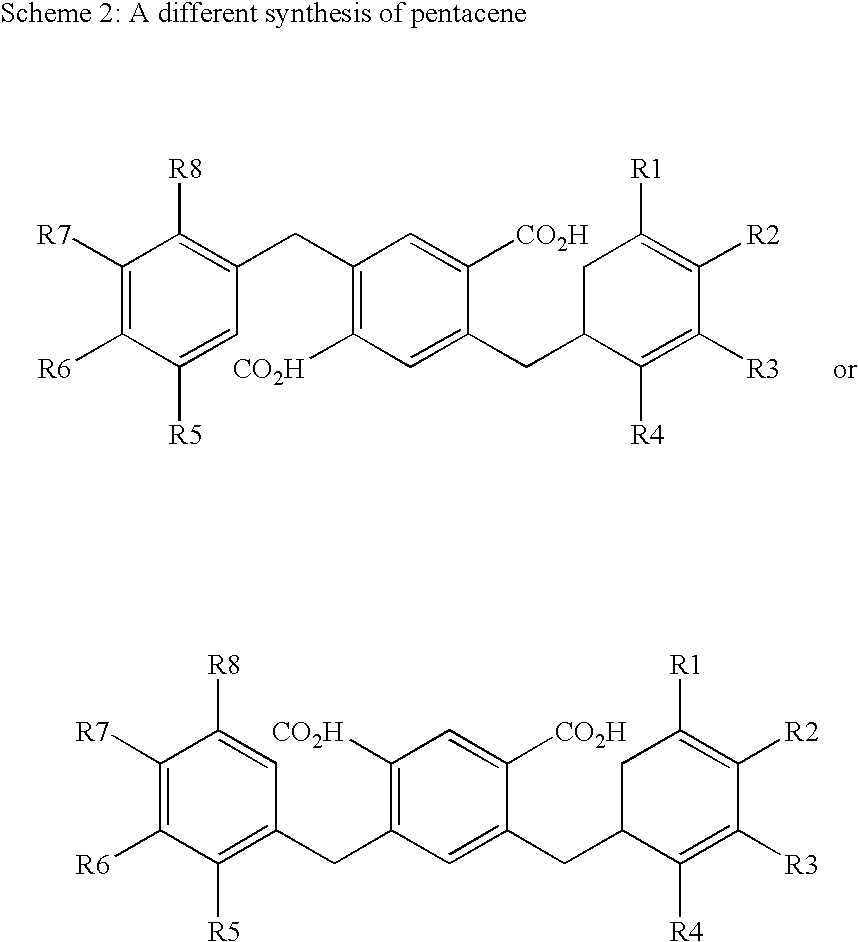Compounds comprising a linear series of five fused carbon rings, and preparation thereof
a technology of fused carbon rings and compounds, applied in the field of pentacene compounds, can solve the problems of preventing solution-based processing, requiring expensive equipment and long pump-down cycles, polymorphic nature, etc., and achieve optimal electronic properties and amenable to further manipulation
- Summary
- Abstract
- Description
- Claims
- Application Information
AI Technical Summary
Problems solved by technology
Method used
Image
Examples
example 1
Cycloaddition with 1,4,5,8-anthradiquinone
[0309]2,9 / 2,10-Bis(t-butyldimethylsiloxy)-5,7,12,14-pentacenediquinone: 1,4,5,8-Anthradiquinone (2.45 g, 10.3 mmol, 1 eq) and trans-3-(t-butyldimethylsilyoxy)-1-methoxy-1,3-butadiene (5.14 mL, 21.6 mmol, 2.1 eq) were combined in CH2Cl2 and stirred at room temperature (22° C.) for 20 h. The reaction was concentrated, taken up in THF, silica gel was added, and the suspension was stirred open to air for 24 h. The reaction was filtered through a silica gel plug with CH2Cl2 to afford the adducts. The plug was flushed with THF to recover the unaromatized material. Silica gel was added to the THF fraction and this slurry was stirred open to air for 24 h. Filtration through a silica gel plug with CH2Cl2 afforded additional product. The silica gel oxidation / filtration was repeated until all of the unaromatized material was converted to the products. The diquinones were isolated as a yellow solid (3.72 g, 60%, 1:1 mixture). The isomers could be separa...
example 2
Cycloaddition with Quinone
[0313]2,9 / 2,10-Bis(t-butyldimethylsiloxy)-6,13-pentacenequinone: (3,4-Bis(dibromomethyl)phenoxy)(tert-butyl)dimethylsilane (1.10 g, 2 mmol) and benzoquinone (218 mg, 2 mmol) were added to the stirred ionic liquid (1-butyl-3-methylimidazolim iodide) (5 g). The mixture was heated to 60° C. and stirred for a further 2 hours. The mixture was washed four times with ether, and the ether layers combined. The ether solution was concentrated under reduced pressure and the solid washed with acetone to afford a mixture (1:1) of the adducts (436 mg, 77%) as a yellow solid. The remaining ionic liquid phase was dried under vacuum and directly reused in the subsequent experiments. Fractional recrystallization from CH2Cl2 gave the pure adducts.
[0314]2,9-Bis(t-butyldimethylsiloxy)-6,13-pentacenequinone: Yellow needles. mp: 1H NMR (300 MHz, CDCl3) δ 8.83 (s, 2H), 8.73 (s, 2H), 7.98 (d, J=9 Hz, 2H), 7.41 (d, J=2.1 Hz, 2H), 7.27 (m, 2H), 1.02, (s, 18H), 0.29 (s, 12H); 13C NMR ...
example 3
Conversion of the Quinone to the Triflate
[0316]2,9-Bis(trifluoromethylsulfonyloxy)-6,13-pentacenequinone: 2,9-Bis-(tertbutyl-dimethylsilanyloxy)-pentacene-6-13-dione (288 mg, 0.5 mmol) was dissolved in THF (150 mL), cooled to 0° C. and TBAF (1.1 mL, 1.1 mmol, 1M in THF) added. After 15 min., Tf2NPh (500 mg, 1.4 mmol) in THF (10 mL) was cannulated into the reaction flask and warmed to 22° C. After 18 h, the reaction was concentrated to 50 mL, diluted with ether, washed with 1 M HCl, 5% NaHCO3, and H2O. The ether solution was concentrated to 30 mL and filtered through a sintered glass funnel to obtain the bis-triflate as a pale yellow solid (278 mg, 90%) that was used directly without further purification for the next step.
PUM
| Property | Measurement | Unit |
|---|---|---|
| sub-threshold voltages | aaaaa | aaaaa |
| dielectric constant | aaaaa | aaaaa |
| dielectric constant | aaaaa | aaaaa |
Abstract
Description
Claims
Application Information
 Login to View More
Login to View More - R&D
- Intellectual Property
- Life Sciences
- Materials
- Tech Scout
- Unparalleled Data Quality
- Higher Quality Content
- 60% Fewer Hallucinations
Browse by: Latest US Patents, China's latest patents, Technical Efficacy Thesaurus, Application Domain, Technology Topic, Popular Technical Reports.
© 2025 PatSnap. All rights reserved.Legal|Privacy policy|Modern Slavery Act Transparency Statement|Sitemap|About US| Contact US: help@patsnap.com



